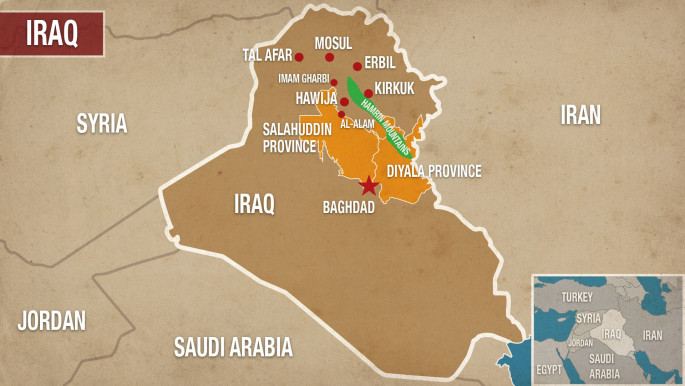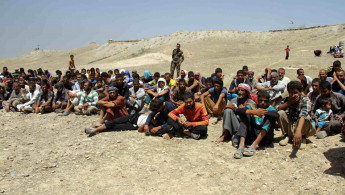The final days of the caliphate in Iraq
Few in Iraq truly believe that the fall of Mosul, and the seemingly imminent recapture of Hawija and Anbar will be the end of the Islamic State group in Iraq. But the chapter of history in which the group has been able to hold and govern swathes of territory is certainly almost finished.
Sources within Hawija, the small Iraqi town barely known to any outside of Iraq until now, paint a picture of disarray, within internal fissures growing, and an increasingly resistant civilian population.
IS fighters with a now-wavering commitment to the cause have been turning themselves in at an unprecedented rate, alongside their families.
 |
Upwards of 200 IS fighters have surrendered either to Iraqi Security Forces or the Kurdish Peshmerga in recent weeks, and more jihadists are giving up the fight every day |  |
On September 2, 30 fighters handed themselves over the Peshmerga after having been assigned to carry out suicide missions. The next day another 30 fled Hawija for the nearby Hamrin Mountains, a long-time insurgent stronghold that the group are widely expected to use as a bolthole once they lose control of the Hawija pocket.
September 3 also saw IS arrest 20 of their own members in the Al-Riyadh district of Hawija. The 20 were preparing to flee, and eyewitness claim the fleeing fighters were denounced as "traitors" and taken to an unknown location.
Various media reports state that upwards of 200 IS fighters have surrendered either to Iraqi Security Forces or the Kurdish Peshmerga in recent weeks, and more jihadists are giving up the fight every day.
Read more: Hawija - the next battle in Iraq's war against the Islamic State group
There is further evidence to suggest remaining IS fighters are growing increasingly desperate. Sources inside Hawija have told The New Arab that IS members had hurriedly begun attempting to sell their confiscated vehicles back to their original owners for anything between $200 to $500.
"[IS] are trying to collect as much money as possible before leaving," one resident said.
Other sources inside Hawija claim the Islamic State group's religious officials and preachers are now "exerting extraordinary efforts to convince [IS] members not to throw away their weapons, and to fight until the end".
After their brutal defeat in Mosul, it appears that the promise of a place in Jannah is increasingly no longer enough.
Those that remain are caught in a crisis of diverging visions for the group. Foreign fighters are largely blamed for the loss of Mosul - so much so that armed clashes erupted within the group in late August.
Foreign-born fighters want to maintain the group's caliphate and open governance of territory. The local fighters, many of whom have been involved in Iraq's jihadist movements for the past 10 years, want to return to the tactics of insurgency.
Thus far, it is the locals who have won out; much of the IS leadership in the pocket is from Hawija itself, or nearby Diyala and Saladin province. The foreign leadership contingent within the Hawija area comprises just two Chechen commanders, such is the foreign fighters' waning influence - a far cry from the caliphate's time when foreign fighters ruled over whole ministries and battalions.
 |
It's not just IS' internal divisions causing the group problems. Local resistance has also grown in recent weeks. It is led by two groups, one known as Fursan Al-Hawija - the Knights of Hawija and the other, Katiba't Hawija - the Hawija Battalions.
The Hawija Battalions are linked to a group that was widely active in Mosul under IS and claim to have hundreds of members. They were primarily a peaceful resistance group, signified by their spray painting of the Arabic letter Meem, short for "Mowqama" - resistance - throughout the city. Recent weeks have seen the graffiti proliferate on walls across Hawija.
 |
With the military gathering outside Hawija, people who have suffered now have the confidence to fight back |  |
September 6 saw Fursan Al-Hawija assassinate IS commander Ibrahim Jasim Mari inside his home in Hawija's Al-Askari neighbourhood. Within the house, a note was left saying only "Fursan Al-Hawijah were here". Locals told The New Arab that this was the first assassination of its kind in Hawija, since IS took over in 2014.
"With the military gathering outside Hawija, people who have suffered now have the confidence to fight back," one resident told us.
But despite the divisions and resistance, the hard core of IS within Hawija remain numerous and steadfast. Yet their reduced numbers are not enough to hold even a relatively small town like Hawija, home to just 70,000 - and this appears to be something of which they are aware.
Some IS militants will surely fight to the death, others will head for the mountains from where they will likely attempt to reignite something resembling Iraq's insurgency in 2006.
During the Battle for Mosul, Iraqi Prime Minister Haider Al-Abadi gave the order to kill every IS fighter in Mosul, despite advice urging him to open a corridor of escape to Syria.
The policy led to the almost absolute destruction of West Mosul. If IS strength continues to ebb at its current rate, the battle for Hawija could potentially hold a far different outcome.
These final days in the Iraqi chapter of the caliphate are growing increasingly dark for the organisation that once ruled over some four million people.
Gareth Browne is a freelance reporter formerly based in Erbil. He has been reporting from the front lines in the battle to retake Mosul from the Islamic State group and recently visited Baghdad to study the legacy of the US-led invasion.
Follow him on Twitter: @BrowneGareth



